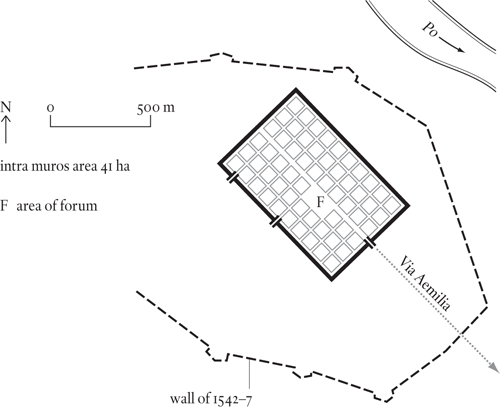
Emilia-Romagna, Italy
Classical Placentia; administrative centre of the eighth Augustan region of Italy, subsequently the province of Aemilia
We know a considerable amount about the first thirty years of Piacenza’s history, but almost nothing about how it fared for the seven centuries after that. Founded in 218 BC, the town was one of a pair of Latin colonies – the other being Cremona – intended to give the Romans a firm grip on the central section of Cisalpine Gaul. The timing couldn’t have been worse. That summer, Hannibal crossed the Alps, descended on the Lombard plain and defeated the Roman army charged with its defence. The would-be settlers had to abandon whatever they had managed to build of their town, and escape as best they could, but in dogged Roman fashion they were back onsite again as soon as Hannibal had moved on. By 207 BC they had put together enough of a town wall to make a successful defence against Hasdrubal, Hannibal’s brother. In 200 BC, however, they were forced out again, this time by the Boii, the local Celtic tribe. Maybe some colonists hung on in there despite all these setbacks, because in 195 BC Ligurian raiders are said to have reached, but not breached, the walls of the town. But if one had to describe the life and achievements of the first generation of Piacentines, it is difficult to avoid using words like ‘uncertain’ and ‘precarious’.
The second generation had a much easier time of it. With Hannibal disposed of – and the monarchs of the Hellenistic East to boot – in 190 BC, Rome was able to dispatch a new tranche of colonists and, more importantly, connect up the colony to the strategic road network. In 187 BC, the consul Marcus Aemilius Lepidus laid out a road that ran straight as a die from RIMINI on the Adriatic to Piacenza on the middle Po; this, the famous Via Aemilia, determined the geography of Roman settlement in the area between the Apennines and the Po. The string of little towns along the route – Forli (Forum Livi), Faenza (Faventia), BOLOGNA (Bononia), Modena (Mutina), REGGIO (Rhegium), Parma and Fidenza (Fidentia) – became the axis of Augustus’ eighth district, more familiarly known as Aemilia (now Emilia-Romagna). Piacenza, its largest town, was its administrative centre throughout the Roman imperial period.
This brings us to the end of what the sources tell us about Piacenza, and as the Roman town is entirely hidden beneath the buildings of the modern city, archaeology has very little to add. This is not to say that all trace of Roman Piacenza has been lost. Almost the entire layout of the Roman town is still visible at the centre of the modern street plan, where only minimal touching up is needed to restore a 41-hectare rectangle made up of sixty square blocks. All but twenty have survived the 2,200 years since the Roman surveyors first drew their outlines.

As to population, the earliest datum is a figure of 27,000 in 1550, when a new wall had just been completed enclosing 290 hectares. On this basis, Roman Piacenza would have had a population in the region of 3,500 and certainly no more than 5,000.